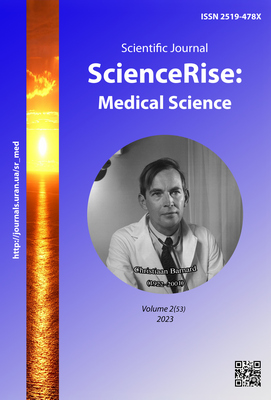Improvement of the methods of stopping nose bleeds in patients under antithrombotic therapy
DOI:
https://doi.org/10.15587/2519-4798.2023.281739Keywords:
epistaxis (nosebleed), antithrombotic therapy, antiplatelet therapy, anticoagulant therapy, hydrotamponAbstract
The aim of the research. Comparative study of the effectiveness of various methods of stopping epistaxis in patients under antithrombotic therapy.
Materials and methods. The study of the effectiveness of various methods of stopping bleeding in 156 patients with epistaxis, which developed against the background of antithrombotic therapy, was conducted. All patients were divided into two groups: the main group (104 patients), in which the stoppage of nosebleeds was carried out by a combined method, which includes the use of a two-chamber hydrotampon of our own design in combination with "Nosochem" gel and thermal exposure, and a control group (52 patients), where classic gauze tamponade of the nasal cavity was used.
Results. The method proposed by us showed its effectiveness in stopping nosebleeds in 100 (96.1 %) patients of the main group. In the control group of patients with gauze tamponade of the nasal cavity, tamponade ensured stable hemostasis in 44 (84.6 %) patients.
Conclusions. The combined method of stopping epistaxis, which includes the use of a two-chamber hydrotampon of our own design in combination with "Nosochem" gel and thermal exposure, is more effective and safer compared to traditional gauze tamponade and can be recommended as the method of choice for stopping epistaxis against the background of antithrombotic therapy. The proposed method is easy to use, provides a reliable hemostatic effect, preserves the function of nasal breathing, reduces the trauma of tamponade and the risk of recurrent bleeding. One of the advantages of the hydrotampon is the absence of the tampon sticking to the mucous membrane and its impregnation with blood and wound exudate, which allows you to extend the period of tamponade if necessary, and the tampon removal procedure is less painful with a lower risk of bleeding recurrence
References
- Stadler, R. R., Kindler, R., Holzmann, D., Soyka, M. B. (2016). The long-term fate of epistaxis patients with exposure to antithrombotic medication. European Archives of Oto-Rhino-Laryngology, 273(9), 2561–2567. doi: https://doi.org/10.1007/s00405-016-3913-9
- Yaniv, D., Zavdy, O., Sapir, E., Levi, L., Soudry, E. (2021). The Impact of Traditional Anticoagulants, Novel Anticoagulants, and Antiplatelets on Epistaxis. The Laryngoscope, 131 (9), 1946–1951. doi: https://doi.org/10.1002/lary.29417
- Escabasse, V., Bequignon, E., Vérillaud, B., Robard, L., Michel, J., Malard, O. et al. (2017). Guidelines of the French Society of Otorhinolaryngology (SFORL). Managing epistaxis under coagulation disorder due to antithrombotic therapy. European Annals of Otorhinolaryngology, Head and Neck Diseases, 134 (3), 195–199. doi: https://doi.org/10.1016/j.anorl.2016.10.001
- Beck, R., Sorge, M., Schneider, A., Dietz, A. (2018). Current Approaches to Epistaxis Treatment in Primary and Secondary Care. Deutsches Ärzteblatt International, 115 (1-2), 12–22. doi: https://doi.org/10.3238/arztebl.2018.0012
- Buchberger, A. M. S., Baumann, A., Johnson, F., Peters, N., Piontek, G., Storck, K., Pickhard, A. (2018). The role of oral anticoagulants in epistaxis. European Archives of Oto-Rhino-Laryngology, 275 (8), 2035–2043. doi: https://doi.org/10.1007/s00405-018-5043-z
- Zahed, R., Mousavi Jazayeri, M. H., Naderi, A., Naderpour, Z., Saeedi, M. (2017). Topical Tranexamic Acid Compared With Anterior Nasal Packing for Treatment of Epistaxis in Patients Taking Antiplatelet Drugs: Randomized Controlled Trial. Academic Emergency Medicine, 25 (3), 261–266. doi: https://doi.org/10.1111/acem.13345
- Tunkel, D. E., Anne, S., Payne, S. C., Ishman, S. L., Rosenfeld, R. M., Abramson, P. J. et al. (2020). Clinical Practice Guideline: Nosebleed (Epistaxis). Otolaryngology – Head and Neck Surgery, 162 (S1). doi: https://doi.org/10.1177/0194599819890327
- Murray, S., Mendez, A., Hopkins, A., El-Hakim, H., Jeffery, C. C., Côté, D. W. J. (2018). Management of Persistent Epistaxis Using Floseal Hemostatic Matrix vs. traditional nasal packing: a prospective randomized control trial. Journal of Otolaryngology – Head & Neck Surgery, 47 (1). doi: https://doi.org/10.1186/s40463-017-0248-5
- Glikson, E., Chavkin, U., Madgar, O., Sagiv, D., Nakache, G., Yakirevitch, A. et al. (2018). Epistaxis in the setting of antithrombotic therapy: A comparison between factor Xa inhibitors, warfarin, and antiplatelet agents. The Laryngoscope, 129 (1), 119–123. doi: https://doi.org/10.1002/lary.27400
- Xu, X., Teng, X. (2015). Effect of fibrinogen on blood coagulation detected by optical coherence tomography. Physics in Medicine and Biology, 60 (10), 4185–4195. doi: https://doi.org/10.1088/0031-9155/60/10/4185
- Smith, J., Hanson, J., Chowdhury, R., Bungard, T. J. (2019). Community-based management of epistaxis: Who bloody knows? Canadian Pharmacists Journal / Revue Des Pharmaciens Du Canada, 152 (3), 164–176. doi: https://doi.org/10.1177/1715163519840380
Downloads
Published
How to Cite
Issue
Section
License
Copyright (c) 2023 Hryhorii Garyuk, Nataliia Bychkova

This work is licensed under a Creative Commons Attribution 4.0 International License.
Our journal abides by the Creative Commons CC BY copyright rights and permissions for open access journals.
Authors, who are published in this journal, agree to the following conditions:
1. The authors reserve the right to authorship of the work and pass the first publication right of this work to the journal under the terms of a Creative Commons CC BY, which allows others to freely distribute the published research with the obligatory reference to the authors of the original work and the first publication of the work in this journal.
2. The authors have the right to conclude separate supplement agreements that relate to non-exclusive work distribution in the form in which it has been published by the journal (for example, to upload the work to the online storage of the journal or publish it as part of a monograph), provided that the reference to the first publication of the work in this journal is included.









